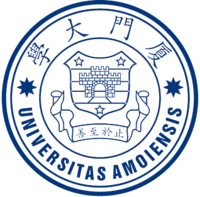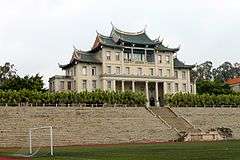Xiamen University
 | |
| Latin: Universitas Amoiensis | |
Former name | Amoy University |
|---|---|
| Motto | 自强不息, 止于至善[1] |
Motto in English | Pursue Excellence, Strive for Perfection[1] |
| Type | National university |
| Established | 1921 |
| President | Zhang Rong |
Academic staff | 4,600+ |
| Students | 28,133 |
| Undergraduates | 17,847 |
| Postgraduates | 8,785 |
| 1,501 | |
| Location | Xiamen, Fujian, China |
| Campus | urban, 524.3 ha |
| Nickname | Xia Da |
| Affiliations | Global U8 (GU8) |
| Website | www.xmu.edu.cn |
 | |
Xiamen University (simplified Chinese: 厦门大学; traditional Chinese: 廈門大學; pinyin: Xiàmén Dàxué; Pe̍h-ōe-jī: Ē-mn̂g Tāi-ha̍k), colloquially known as Xia Da (Chinese: 厦大; pinyin: Xià Dà), is a public university in Xiamen, Fujian, with strengths in economics and management, fine arts, law, chemistry, journalism, communication, and mathematics.
Xiamen was the first university in China founded by a member of the overseas Chinese diaspora. It is now a top-ranked university directly administered by the Chinese Ministry of Education[2] and recognized as a Class A institution in the Double First Class University Plan, a government initiative to cultivate a group of elite Chinese universities into "world-class" institutions.[3]
As of September 2017, the university's entering class is over 10,000 first-year students.[4]
History

In 1919, Tan Kah Kee (also known as Chen Jiageng, 陈嘉庚), a notable overseas Chinese businessman, community leader, and philanthropist, donated millions of dollars to establish and endow Amoy University in the city of Xiamen. The university was then founded in 1921. Tan transferred administration of Amoy University to the Nationalist government in 1937, and the institution became a national university.
At the 1926 Sesquicentennial International Exposition in Philadelphia, United States, Amoy University was one of five institutions selected to participate in an exhibit on education in China, representing the country's higher education system.[5]


In 1938, at the outbreak of the Second Sino-Japanese War, the university temporarily relocated to Changting in western Fujian to escape the Japanese invasion of Chinese coastal regions.
At the end of World War II in 1946, Amoy University moved back to Xiamen and resumed normal operations. In 1952 it became a comprehensive university embracing both arts and science. In 1963, it was designated as a state key university.
In the 1970s, the institution's English name was changed to Xiamen University[6] referring to Xiamen, the new English name for Amoy.
In 1995, Xiamen University was selected to participate in the 211 Project, a national government initiative to provide increased financial resources for China's most promising universities.[7] In 2000, the university was selected for the 985 Project, a national and local government initiative to provide funding for facilities construction and faculty hiring to bolster China's top universities.[7]
In September 2017, Xiamen was recognized as a Class A institution in the Double First Class University Plan, a national government initiative to cultivate a group of elite Chinese universities into "world-class" institutions by 2050.[8]
International cooperation
Xiamen University has maintained a global presence since its creation in 1921, attracting students from overseas Chinese communities in Southeast Asia, particularly Malaysia. The institution established an "Overseas Correspondence Courses" program in 1956 and accepted its first foreign students in 1981.[9]
As of March 2016, Xiamen University has global exchange and cooperation relationships with over 300 universities.[10] It has established 16 Confucius Institutes with partner institutions in 13 countries.[10]
In 2011, Chinese Premier Wen Jiabao and Malaysian Prime Minister Najib Razak began high-level discussions about creating a Malaysian branch of Xiamen University.[11] Subsequently, in 2015 the Xiamen University Malaysia Campus was established. Known as "XMU Malaysia", the institution has been described as "historic" and is notable as the "first ever large-scale international branch" of a Chinese university.[12] Professor Wang Ruifang was named the first chancellor of XMU Malaysia.[11]
On 23 May 2016, Xiamen University sent a delegation to the Tokyo Institute of Technology in Tokyo, Japan to meet with leadership and professors. The delegation's objective was to discuss the institutions' strategies for commercializing research findings, fostering university-industry collaboration, and encouraging international students to learn about local language and culture.[13]
On 18 November 2016, Xiamen University and Cardiff University in Wales, United Kingdom initiated a "strategic partnership" including a program for co-supervision of doctoral students, and £1.2 million in seed funding for "collaborative research projects" to benefit the economy of Wales.[14] Subsequently, a delegation from Cardiff University visited the Xiamen University School of International Relations to explore possible areas of research collaboration and student exchange.[15]
Main campus and branch campuses
The main campus of Xiamen University is located in the Siming District in southwestern Xiamen. It is situated at the foothills of mountains, facing the ocean and surrounded by Xiamen's bay. The campus is picturesque, with beautiful scenery and parks. The main campus is a major tourist attraction in Xiamen, itself a popular tourist destination.
The main campus of Xiamen University has a built area of 2.6 million square meters and its libraries hold 3.5 million volumes. The scope and level of its campus high-speed information network is rated first among all universities in China and has become one of the main nodes of CERNET2.
The university also has campuses in Xiang'an district of Xiamen[16][17] and in Zhangzhou, Fujian.
In September 2012, Xiamen University began operations at its Xiang'an Campus, located 34 kilometers from the main campus in Siming District. The three stated goals of the new campus are to provide facilities for "newly developing disciplines and applied subjects" such as bioscience and energy, to establish "innovation platforms for applied sciences", and to house the southern headquarters of the Confucius Institute.[18]
Currently, the Xiang'an Campus hosts over 10,000 students and faculty from ten schools: the Overseas Education College (which serves international students), the Medical College, the School of Pharmaceutical Sciences, the School of Life Sciences, the School of Public Health, the Nursing Department, the College of Earth Sciences, the College of Environment & Ecology, the School of Energy Research, and the School of Aerospace Engineering.[16]
The Xiamen University Malaysia Campus, or "XMU Malaysia" is a branch of Xiamen University maintaining close ties with the main campus, although it functions as its own university and has its own admissions office.
Faculties and research institutes
As of 1 September 2017, Xiamen University consisted of 20 schools with 44 departments, along with many key research institutes.
- School of Humanities
- School of Foreign Languages & Cultures
- School of Journalism & Communication
- School of Law
- Tan Kah Kee College
- Xiamen Academy of International Law[19][20]
- School of Public Affairs
- School of Economics
- Wang Yanan Institute for Studies in Economics
- School of Management
- College of Art
- College of Chemistry & Chemical Engineering
- School of Physics and Mechanical & Electrical Engineering
- College of Oceanography & Environment
- School of Life Science
- School of Information Science & Technology
- School of Electronic Science &Technology
- School of Mathematics
- Software School
- Medical College
- School of Architecture and Civil Engineering
- Overseas Education College
- Adult Education College
- Professional Technical College
- Internet Education College
- School of Pharmaceutical Sciences
Notable alumni
- Gregory Chow – economist
- Chen Jingrun – mathematician
- Lin Yutang – Chinese writer and inventor
- Yu Guangzhong – Taiwanese writer, poet, educator, and critic
- Xie Xide – president of Fudan University from 1983 to 1989
- Lu Xun – writer
- Raymond Lam – Hong Kong artiste and singer (enrolled for one year, 1996)
- Faye Wong – singer
- Zhang Gaoli – CPC Tianjin Committee Secretary and member of Politburo of the Communist Party of China
- Li Wo-shi – magistrate of Kinmen County
See also
- List of universities in China
- GU8 Global consortium of 8 universities
References
- 1 2 "Hallmarks". Xiamen University 90th Anniversary Celebration. Xiamen University. Archived from the original on 4 April 2013. Retrieved 14 July 2014.
- ↑ https://www.natureindex.com/
- ↑ "教育部 财政部 国家发展改革委 关于公布世界一流大学和一流学科建设高校及建设 学科名单的通知 (Notice from the Ministry of Education and other national governmental departments announcing the list of double first class universities and disciplines)".
- ↑ "Over 10,000 freshmen register at Xiamen University - Xinhua | English.news.cn". www.xinhuanet.com. Retrieved 2018-02-10.
- ↑ "Xiamen University´s Glorious Historical: Participant in 1926 Philadelphia World Expo". ice.xmu.edu.cn. Retrieved 2018-02-10.
- ↑ "Google Books Ngram Viewer: Amoy University, Xiamen University". Retrieved January 23, 2016.
- 1 2 "Best universities in China 2018". 6 September 2017.
- ↑ "China to develop 42 world-class universities". People's Daily. 21 September 2017.
- ↑ "Xiamen University on the global stage". ice.xmu.edu.cn. Retrieved 2018-02-10.
- 1 2 "Overview". en.xmu.edu.cn. Retrieved 2018-02-10.
- 1 2 "Xiamen officially opens - Nation | The Star Online". www.thestar.com.my. Retrieved 2018-02-10.
- ↑ Bevins, Vincent; Phillips, Tom (2017-07-07). "'Going global': China exports soft power with first large-scale university in Malaysia". the Guardian. Retrieved 2018-02-10.
- ↑ "Xiamen University delegation visits Tokyo Tech". Tokyo Institute of Technology (in Japanese). Retrieved 2018-02-10.
- ↑ "Cardiff University". Cardiff University. Retrieved 2018-02-10.
- ↑ "School delegation visits partner university in Xiamen". Cardiff University. Retrieved 2018-02-10.
- 1 2 WOXnews.com (10 August 2012). "Xiang'an campus of Xiamen University to open in September". Whats on Xiamen, Inc.
- ↑ China Daily (10 April 2011). "Construction of Xiamen University Xiang'an Campus kicks off". Whats on Xiamen, Inc.
- ↑ "About Xiang'an Campus". liuxue.xmu.edu.cn. Retrieved 2018-02-10.
- ↑ Aizenstatd, Najman Alexander (Fall 2010). "International Law in China: The Xiamen Academy of International Law" (Special China Issue, ). International Law Quarterly, Florida State Bar: 26. SSRN 1724504.
- ↑ Xiamen Academy of International Law Website
External links
| Wikimedia Commons has media related to Xiamen University. |
- Official website (in English)
Coordinates: 24°26′18″N 118°05′35″E / 24.438259°N 118.093153°E